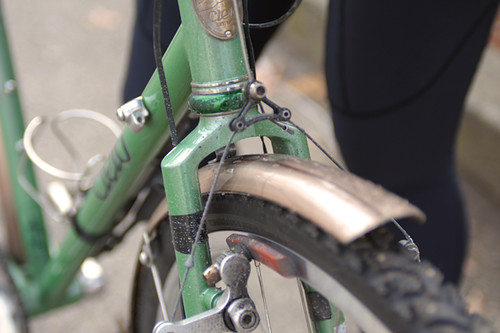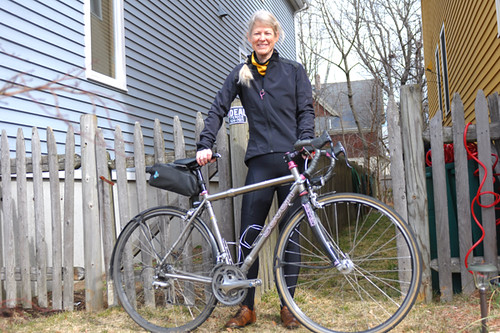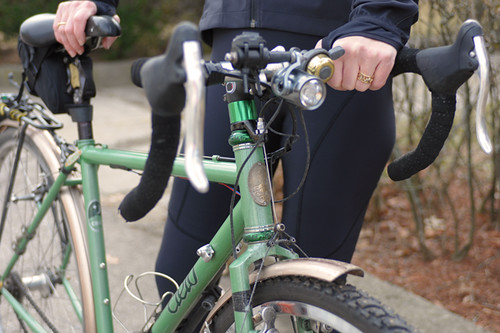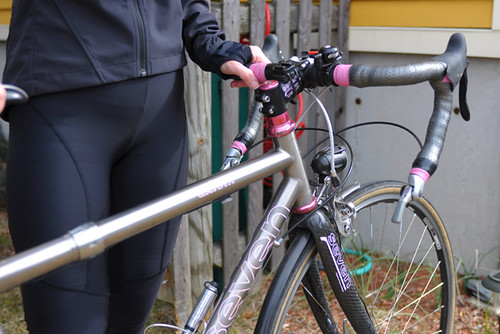Aesthetics of Use
This morning I came across the phrase "aesthetics of use" when it appeared in Bill Strickland's description of his muddy cycling shoe. It is a term I often hear thrown around by artists and designers. In essence, it means that to see an object in use is beautiful - that an object reveals its true self not on display, but in action. Some makers like to think of the aesthetic direction their objects take in the new owners' hands as a happy surprise. Others try to control it. Others still encourage what might be called hyper-use (or at least superficial signs of such), believing that distress enhances the appeal of their creations. These attitudes can be discerned in the manner manufacturers describe and promote their products. Owners' attitudes run the gamut as well. Some emulate the manufacturer's vision in their use of the object, while others are intent on making it their own.
Thinking of these differences, I am reminded of Pamela Blalock's bicycles. A local randonneur who probably spends more time in the saddle than not, she has a few bikes and they are very nice ones. At some point I had it in mind to test ride and feature some of them here. But the more I examined them, the more I realised that the bikes say more about Pamela herself than they do about the manufacturers and models they started out as.
Befendered, weathered from winter commutes, and covered in all manner of curious contraptions, "Cielo Cross bike" hardly seems like an apt description for the magnificent creation that is the Green Queen - Pamela's transportation bike. Fixed gear, rear rack, dynamo lighting, possibly more than one bell - these things make sense to her; the bike is clearly built with a purpose.
Neither is it really accurate to describe her roadbike as a Seven Axiom and leave it at that. While I do not think Pamela was the first to put dynamo lighting and bar end shifters on a Seven, she certainly managed to do it in a way that looks eye-catchingly unusual - blurring boundaries between racing and utilitarian riding and making others question their own understanding of these boundaries. The visually distinct setup reflects preferences that developed out of personal experience. Pamela came up with these ideas from doing years of long brevets and endurance races. It's what works for her in use, and the aesthetics are merely a by-product.
We all have our own ways of using objects, of gaining experience, and then of changing the way we use objects as a result of what we learn from experience. We can follow a manufacturer's vision, we can imitate those whom we admire, we can heed the advice of the more knowledgable. But ultimately we each have our own trajectory to follow. Aesthetics of use are personal; they are not generic, rigid ideas of how an object ought to be utilised.






One of my favorite examples of aesthetics of use, which is interesting on several levels, is Tom Ritchey and his Scott Spark. I guess you could call it the electric tape and zip tie look. Here's a master craftsman who built his first bike at 15 and went on to found a component empire. (Note also the shaved crankarms.) I like it!
ReplyDeleteThis topic reminds me of the photos of people who look like their pets. You can insert other things as well (cars, houses . . . ). Sorry to call pets objects, but they are, as are we. One of the most striking examples of a person matching their car was a pairing I saw on the Bay Bridge. Driver: neatly parted bright red hair and green sweater vest. Car: vintage bright green BMW sedan (80s). Either the pairing was purely organic and unconscious or he was after a particular look and achieved it superbly.
ReplyDelete"Aesthetics of use are personal; they are not generic, rigid ideas of how an object ought to be utilised. "
ReplyDeleteThis statement has broad applicability to any number of aesthetic paths you've trod down the last 3 years. I wonder if you actually believe it.
Ah, "aesthetics of use" is so much prettier than "Frankenbiked", which is what I say I've done to the road bike I use as a commuter. I like it.
ReplyDeleteI was looking at a collection of titanium bikes and my steel bike at the coffee shop/bike studio this morning. Though I am envious of owners of Ti bikes for certain reasons, my bike was the pretty one. Why? It's mine: my color, my fenders, my choices, and, most importantly, the 7000 miles that I rode it, including the 50 miles that I rode it this morning. Nothing is better than that. Pamela's bikes are pretty in some ways but her choices don't make that much aesthetic sense to me - and why should they? She needs to satisfy only herself and that satisfaction is both from aesthetics and utility.
ReplyDeleteIt is a treat to see these machines and their expression of the experience and background of a standout cyclist and athlete. Ms. Blalock's lively accounts of her rides and cycling adventures are so enjoyable and inviting and she is so generous in sharing them! And she is so modest about awesome cycling accomplishments. Thank you. Jim Duncan
ReplyDeleteClosely allied is the concept of beausage (portmanteau of beauty and usage), of which I'm surprised to find no instances on _Lovely_Bicycle_. It's a Grant Petersen thing: http://metacool.typepad.com/metacool/2005/05/beausage.html
ReplyDeleteWasn't it a thing before Grant Petersen?
DeleteI've never really felt that I own something until I've tweaked, modified, repaired or changed it in some way, particularly intensely personal items like bicycles and musical instruments (to the point with the latter where my main stage instrument is one I built myself).
ReplyDeleteA lot of the better cyclists I know (and I say "better" not meaning "faster" but "more fun") love to tinker and change things up, whether it's swapping parts or improvising connections. I think the sense of ownership is similar to what I feel, and I wonder that if a manufacturer ever made a bicycle that was perfect "out of the box," some of us would absolutely hate it because we didn't get to modify it as soon as we got home.
You hear it said, 'a painter's painter' -- Those bikes are hard earned!! Not everyone 'gets' it, but folks who ride do, and always stand and stare a little extra at both the bike and the rider! So even if the choices are different than you might choose, the respect is there and, man, those are cool bikes! Beauty is what works and if something doesn't add, it detracts.
ReplyDeleteIt is worth adding that the fine lady featured here must have gone through a dozen bikes over the years. The secret to knowing what you like is trial and error.
ReplyDeleteThe Green Queen (and it's predecessor) has often served as a test-bed for lights. Nighttime commutes are a great way to test new lights. Sometimes I want to compare two lights, and it's nice to be able to switch easily between two. It's also handy to have a backup should a new light prove to be not up to the job. I had also been testing different bike computers and GPS devices. This is why I had all that excess stuff in these photos. It is a bit cluttered, but will be made to look more elegant and simple again soon. The mudflap is a reflection on my warped sense of humor, and it makes the too short hack of a fender work better!
ReplyDeleteThe bar-end shifters on the Seven reflect the inability to teach and old dog new tricks. I started using this style of shifters around 30 years ago (250,000 miles ago). My hands simply expect shifters either to be there - or no where (fixie). I've tried brifters, but my hands still expect the shifters to be at the ends of the bars, and I will move my hands from the brifters to the empty air at the end of the bars to try to shift. I gave up trying to change. If my bike has a derailleur, it has bar-end shifters!
I can go to bike shows and galleries and look at lovely clean, simple and elegant bikes and appreciate their beauty, but I really appreciate the beauty of the scenery on a bike ride far more, and my cluttered utilitarian non-aesthetically appealing bikes get me to that beauty, making them aesthetically useful, eh?
Another thing -- the term, just like Bill's never ending page load, just strikes me as so much self-indulgence. The amount of character and ingenuity that I run into on a regular basis tied to bikes of the poor or homeless is incomprehensible to the majority of bike publications and the consumers of them.
ReplyDeleteSorry, there I go again thinking about the broader social context of bike aesthetics. Shame on me.
The poor and the homeless are as likely to have an aesthetic as any other human.
DeleteYou need to explain further why acknowledging this should be controversial as your post appears to suggest.
No, I do not "need" to explain further.
DeleteI had something typed up that backed up my point, but I think I shall with hold it.
Perhaps need is a poor choice of words.
DeleteIt would certainly have been helpful to elaborate if you want others to understand your argument.
From your follow up, it appears you would rather not. Fair enough.
My response is readily comprehensible to me and, I'm sure, to at least some others. If you don't know what I mean then maybe a few more years on this planet will elucidate.
DeleteAnd no, I don't intend this comment to be cutting.
"Others try to control it"
ReplyDeleteSome of you may be too young to remember an ad showing a photo of David Bailey's Pentax 1000 with black paint worn to bare brass. I thought it was beautiful and as a student of design sought to emulate the great photographer and (foolishly) rubbed the paint off my unspoilt black painted Pentax 1000 so rendering it worthless. I regret that decision now, but, as I said I was foolish. Now, older and wiser and in possession of an equally beautiful Nikon FM3A. I handle it with cotton gloves and dare not get a scratch on it, however a part of me dearly wants to use it normally every day and see the gentle patina of age appear, like Pamela's bikes.
Sometimes I think good taste or having an eye for beautiful things whether certain bikes or particular cameras is nothing less than an affliction.
Minor point: Pamela's bikes aren't old, they're just (in one case) dirty and apparently cluttered, for perfectly functional reasons. So, concepts of patina, beausage, wabi-sabi are, while all worth discussing, not quite to the current point.
DeleteI have scratches + worn paint on my black FM3a :)
Delete(Now my silver FM3a is pretty much mint...)
I can't believe there are others here with multiple Nikon FM3As. Velouria you need more photography posts where we can discuss this stuff!
DeletePamela's bikes are amazing.
The *bikes* per se may not be old, but they have old souls and in many cases, old parts with some mixture of new. The Green Queen replaced a Ted Wojcik frame that rusted out at the bottom bracket after many years of commuting in New England winters. It was almost a straight swap of parts from one to the other. The rear hub is my original fixed hub and is more than 15 years old and has stories to tell. The too-short gold fenders are similar vintage.
DeleteThe Seven took on the role of long distance bike, previously held by my pink Indy Fab, and got many of it's parts from that bike - including the pink hubs, which is how it ended up pink. And it's pink - because I am one tough old broad who can have any darn color she wants. The Seven also enjoys the benefits of being a travel bike. And again, while not old, I have logged over 10,000 miles since getting it 18 months ago!
The Indy Fab got converted to a fixed mountain climbing machine. It gets ridden about 30 miles per year now, and then gets to rest!
So the only truly old thing associated with my bikes is the rider. Nothing is retro or vintage for the sake of being retro or vintage. It's there because it works for *me* or appeals to my somewhat quirky tastes!
I love this new term!
For those who really want to know...
There's a bit more detail about the Green Queen here
http://blayleys.blogspot.com/2012/01/35f-and-sunny.html
and the Seven here
http://blayleys.com/articles/bikes/index.html
Again, what a pleasure to read this blog and its comments.
ReplyDeleteSince "Wabi-sabi represents a comprehensive Japanese world view or aesthetic centered on the acceptance of transience and imperfection" some further reading might start at:
http://en.wikipedia.org/wiki/Wabi-Sabi
Are the handlebars on that Seven higher than the saddle or is it just the angle of the photo?
ReplyDeleteThe bars on the Seven are about 1/2 inch below the height of the saddle - possibly a reflection of the long-distance nature of most of my rides, or possibly a reflection of my 51 years of existence, since the Cielo (Green Queen), which is mostly used for commuting has a similar setup. I have about a 2 inch drop on my hill-climb race bike, but once you factor in the angle of the hillclimbs - it's cancelled out :-)
DeleteI would be very interested in a ride report of that Cielo
ReplyDeleteI've published a bit on info on my blog, and the Lovely Biker is more than welcome to take it out for a proper test ride, whenever she would like.
DeleteThe bike owner appears to be wearing Dromarti shoes.
ReplyDeleteAre they comfortable?
I bought mine a month ago after seeing them on Velouria's flickr. They are comfortable, the leather is great quality, and I am complimented on them constantly even off the bike! I do not use clipless pedals and got the version without clips.
DeleteYes, I love the Dromarti shoes. My first proper pair of cycling shoes (27 years ago) was a pair of Kangaroo leather Marresi shoes (Marresi makes the shoes for Dromarti). I loved these shoes. At the time, they cost a week's pay. Look pedals came out shortly after I spent all my grocery money on the shoes and the sole was too curved to work with a Look cleat. I suffered with toe clips for a while until I finally switched to Looks and as soon as recessed cleats came out, switched again. When Dromarti first advertised these shoes I had to have a pair. I've had them for three years now. They are the most comfortable pair of shoes I have. They have survived biblical rain and searing heat. I have treated them with waterproofing from Limmer and brown shoe polish. Love them!
DeleteI wholeheartedly agree that a bike is not well-used or loved until it's customized to the rider and it's intended use. It's what makes all of our bikes unique.
ReplyDeleteWhat good is a bike if it's only to be looked at? Even works of art are meant to be experienced. Beauty is derived from that connectedness and to use and adapt a bike in order to reach such a state makes it a necessary tool for happiness :)
ReplyDeleteThat mudflap on the Green Queen looks just like the ones on my pickup!
ReplyDeleteThis part of the intro essay I wrote for the chapter, "Equipment," in The Quotable Cyclist, got stuck in my head after reading all this:
ReplyDeleteOne of the people I was lucky enough to work with at Bicycling magazine for awhile was Jim Langley, who not only just might be one of the best bike mechanics in the world but cares about bikes more than anybody I know. I don’t mean that Jim loves cycling more than anyone else, or that he knows more about bicycles than everyone. (Although both of those things are possible — he’s the kind of guy who restores highwheelers but can also rebuild a full suspension bike disassembled down to the tiniest washer without previously seeing the thing intact.)
What I’m trying to describe is something in Jim that I haven’t seen in any other cyclist in quite the same way — a kind of bikish empathy. When Jim sees a bike he doesn’t just see a bike. He sees each part of the bike and he understands intuitively what each part of the bike does and how — yet at the same time it’s not a disjointed vision, and not one that’s solely mechanical. He knows that each bike has a personality, and an ancestry, and its own stories, if that makes any sense at all. It’s not quite as freaky in reality as I make it sound here. I’m just trying to say that Jim relates to the human part of the machine, the part most of us can see only in our own, oldest and most loyal bikes. (Conversely, sometimes when he looks at riders I get the feeling Jim is learning something about their bikes as well.)
This topic has great potential for extended exploration both in discussion and visually...amidst all the interesting "bike style" books I see coming out, and the practical perspectives (bike snob and Grant Peterson), this is a captivating topic that many of us KNOW from experience. I like that it provides a space for those of us who cannot afford (immediately) a hand built bike, or custom bike with all VO parts...over time, as we use the bike, and alter it to our needs and yes, desires, an aesthetic is created...this could be a whole blog unto itself
ReplyDelete